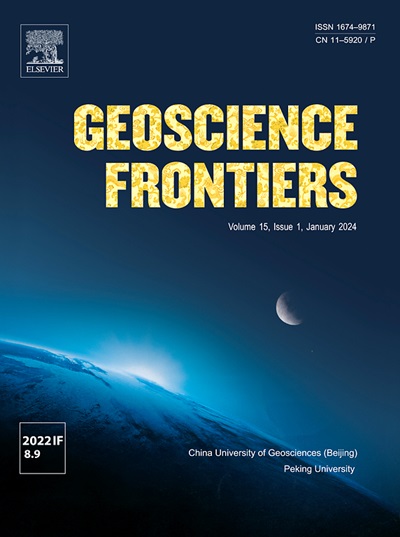Formation of the rare Xiaoqinling Au-Mo province: Timings and geodynamic triggers
IF 8.9
1区 地球科学
Q1 GEOSCIENCES, MULTIDISCIPLINARY
引用次数: 0
Abstract
The timings and geodynamic controls of Mo, Au, and Au-Mo deposits in the Xiaoqinling Orogen (> 630 t Au and 115, 000 t Mo), a rare Au-Mo province globally, are addressed by a combination of mineral parageneses, crystalline mineralogy, geochemistry, and Re-Os and U-Pb geochronology in the Dahu, Qinnan, and Yangzhaiyu deposits. The Xiaoqinling Orogen comprises an E-W-trending fold and thrust system with repeated structural reactivation and the Mo or Au orebodies in these deposits are dominantly controlled by E–W-trending and NW–SE-trending shear zones. Molybdenum mineralization related to K-feldspar alteration comprises early molybdenite, pyrite, rutile, and monazite within gray quartz veins plus late molybdenite and pyrite within white quartz veins in the Dahu and Qinnan Au-Mo deposits. Early and late Au mineralization events have similar mineral assemblages of pyrite, native gold ± Au-Ag-Te minerals, rutile, and monazite associated with quartz-sericite alteration at Yangzhaiyu. The early disseminated molybdenite is characterized by rhombohedral polytype and oscillatory Re zoning, in contrast to the late molybdenite with a coexistence of rhombohedral and hexagonal polytypes and irregularly distributed Re. The early molybdenite has a Re-Os isochron age of 222.5 ± 1.3 Ma, compatible with a monazite U-Pb age of 224 ± 6.1 Ma, whereas late molybdenite provides a Re-Os isochron age of 185.0 ± 12 Ma, with the implication that the 3R-polytype molybdenite with oscillatory Re zoning is more suitable for high-precision dating. The early and late Au mineralization have a pyrite Re-Os age of 202.0 ± 5.9 Ma and U-Pb age of 124.0 ± 1.3 Ma, respectively. In accordance with its complex geodynamic setting, geological and geochronological studies record a complicated 100-million-year mineralization history with multiple magmatic-hydrothermal Mo and orogenic Au mineralization events that formed within a structural framework of multiply reactivated shear zones.

稀有金钼矿小秦岭的形成:时间和地球动力学成因
小秦岭造山带Mo、Au和Au-Mo矿床的成矿时代及地球动力学控制[j];通过对大湖、秦南和杨寨峪矿床的矿物共生、结晶矿物学、地球化学和Re-Os、U-Pb年代学的综合研究,对全球罕见的金钼矿(630t Au、115000 t Mo)进行了研究。小秦岭造山带为东西向褶皱逆冲构造,构造活动频繁,钼矿床中Mo、Au矿体主要受东西向和nw - se向剪切带控制。与钾长石蚀变有关的钼矿化主要包括灰色石英脉内的早期辉钼矿、黄铁矿、金红石、独居石和白色石英脉内的晚期辉钼矿、黄铁矿。早、晚金成矿事件具有相似的黄铁矿、原生金±Au- ag - te矿物、金红石和与石英绢云母蚀变有关的独居石矿物组合。早期浸染辉钼矿具有菱形多型和振荡Re分带的特征,而晚期辉钼矿则具有菱形和六边形多型共存的特征,Re分布不规则。早期辉钼矿的Re- os等时线年龄为222.5±1.3 Ma,与独居石的U-Pb年龄为224±6.1 Ma相容,而晚期辉钼矿的Re- os等时线年龄为185.0±12 Ma。表明具有振荡重分带的3r多型辉钼矿更适合高精度定年。金成矿早期和晚期黄铁矿Re-Os年龄分别为202.0±5.9 Ma和124.0±1.3 Ma。根据其复杂的地球动力学背景,地质和年代学研究记录了一个复杂的1亿年成矿历史,在多个恢复剪切带的构造框架内形成了多次岩浆热液Mo和造山带Au成矿事件。
本文章由计算机程序翻译,如有差异,请以英文原文为准。
求助全文
约1分钟内获得全文
求助全文
来源期刊

Geoscience frontiers
Earth and Planetary Sciences-General Earth and Planetary Sciences
CiteScore
17.80
自引率
3.40%
发文量
147
审稿时长
35 days
期刊介绍:
Geoscience Frontiers (GSF) is the Journal of China University of Geosciences (Beijing) and Peking University. It publishes peer-reviewed research articles and reviews in interdisciplinary fields of Earth and Planetary Sciences. GSF covers various research areas including petrology and geochemistry, lithospheric architecture and mantle dynamics, global tectonics, economic geology and fuel exploration, geophysics, stratigraphy and paleontology, environmental and engineering geology, astrogeology, and the nexus of resources-energy-emissions-climate under Sustainable Development Goals. The journal aims to bridge innovative, provocative, and challenging concepts and models in these fields, providing insights on correlations and evolution.
 求助内容:
求助内容: 应助结果提醒方式:
应助结果提醒方式:


